
Images of the Ruling Class and The State
[Updated May 19, 2023]
I have gathered here some of the caricatures and other images which depict the ruling class and the state in a classical liberal manner.
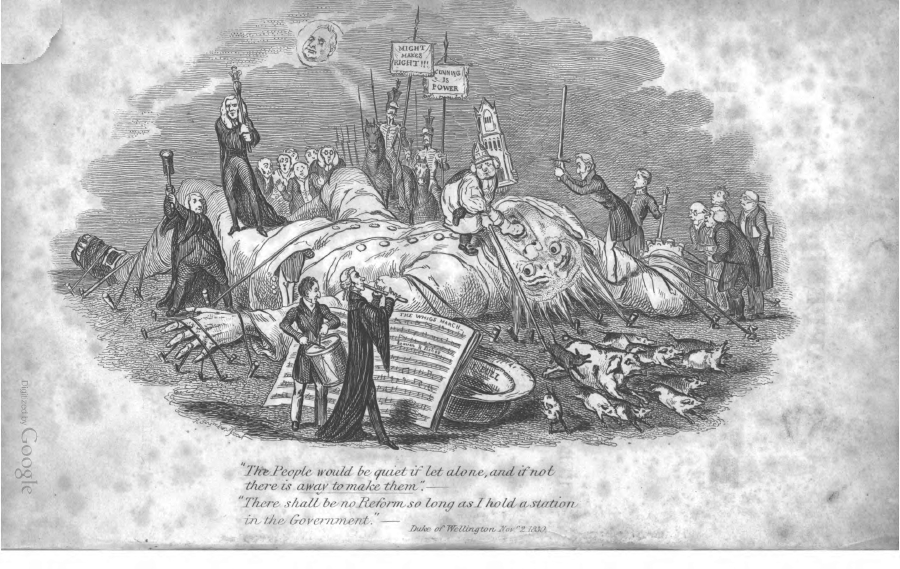 |
(Unknown artist), “John Bull as
Gulliver” (1835) |
John Bull (i.e. the British people) has been captured and tied down (like Gulliver in Jonathan Swift’s Gulliver’s Travels (1726) by the Lilliputians, who in this case are figures representing the army, the church, members of parliament, and the judiciary. The Lilliputians taunt him and rifle his pockets to steal his money. Source: John Wade, The Black Book: An Exposition of Abuses in Church and State, Courts of Law, Municipal Corporations, and Public Companies; with a Précis of the House of Commons, Past, present, and to come. A New Edition, greatly enlarged and corrected to the present time. By the Original Editor. With an Appendix (London: Effingham Wilson, Royal Exchange, 1835), p. xxxiv. |
The Ruling Class as
"Tax Eaters" |
 |
| In the United States April 15 is the day all tax returns must be filed (April 18 in 2011 because of a public holdiay for federal workers). In honour of this important day we have gathered several illustratons and quotations which explore the idea that society is divided into two groups: that of the net tax "consumers" (or tax "eaters" as they are sometimes called) and that of the net tax "payers". These two groups have opposite interests and are therefore in conflict with each other: the tax "eaters" wanting to maintain or even increase their "food intake" and the tax payers wanting to minimize or even eradicate the amount they have to pay. This caricature from 1831 shows how Daumier thought ordinary people were exploited by the ruling elites through taxation and regulation. It was created at a time when agitation for democratic reforms were strong in both England and France and was drawn by the French republican artist Honoré Daumier for a satirical magazine in 1831. It depicts a fat and pear-shaped King Louis Philippe as a "tax eater" (the "Gargantua" from Rabelais' novel) who takes from the ordinary people and gives privileges to the ruling elite. The taxpayers (to the right) are loading baskets full of their tax money which are carried up a ramp into the king’s open mouth. Some well dressed citizens gather around his feet to collect the coins which fall to the ground. From the king’s commode (or toilet) fall official documents which grant various privileges and honours to those waiting below, before they rush off to the National Assembly in the background. For making this drawing Daumier spent 6 months in prison for offending the king. [more] |
Honoré Daumier, “Gargantua” (1831)
[See larger image 1400px] |
 |
James Gillray, "The British Atlas, or John
Bull supporting the Peace Establishment (1816) |
Honoré Daumier, "The Army Hierarchy" (1850s) |
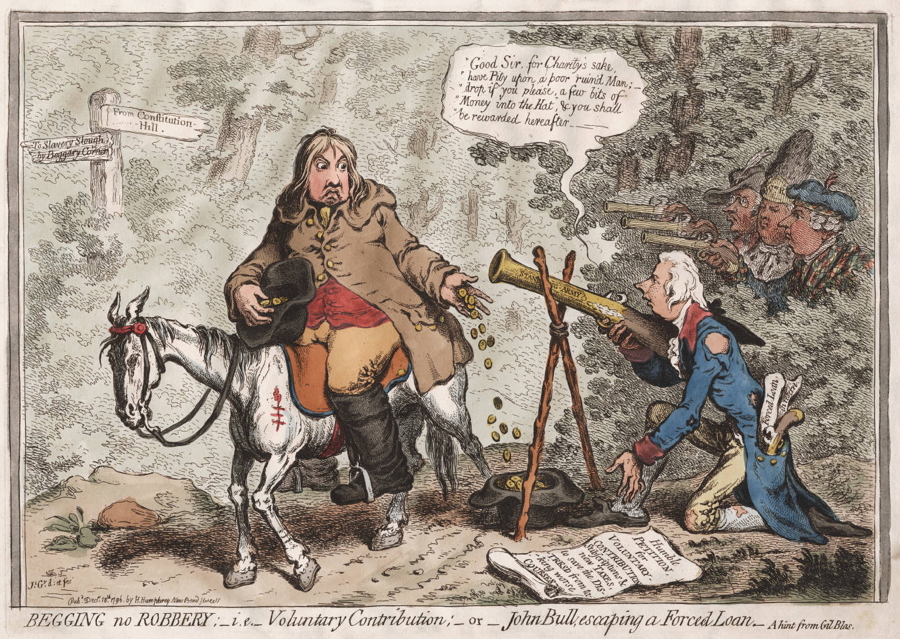 |
"BEGGING no ROBBERY; i.e. Voluntary Contribution; or John Bull escaping a Forced Loan" (1796) |
| This is one of several caricatures Gillray did about the "voluntary loan" which was a thinly veiled threat by the government that a "forced loan" would be imposed on taxpayers to raise money for the war effort if they did not make "voluntary" contributions to the exchequer. The government created war hysteria of a French invasion or of domestic revolution in order to frighten members of the public ("John Bull") into making contributions to the government. The author and politician Edmund Burke was very active in contributing to this hysteria with his writings in 1795 on "Letters on a Regicide Peace" (1795) in which he described the French Revolution and its supporters as a "cancer" which had to be cut out of the body politic. Wright and Evans [p. 89] believe that Burke is one of the "three banditti" in the bushes to the right (Dundas, Grenville, and Burke) and that the scene is a parody of the picaresque novel Histoire de Gil Blas de Santillane (1715) in which Gil Blas, the son of a poor stablehand and chambermaid, encounters robbers on his way to the University of Salamanca, is forced to assist them, and therefore runs afoul of the law. Here we see John Bull riding an emaciated horse which looks like it is on its last legs. He has come from "Constitution Hill" and is on his way to "Slavery Slough ("swamp") via Beggary Corner". He has been waylaid by highwaymen hiding in the bushes as he rides by and is obliged to make a "donation" of coins into their hat instead of being forced to make a loan to the government to fund the army. Note the pained expression on his face. The men in the bushes on the right have pistols pointed at him and are wearing fine robes and hats which suggest that they represent the aristocracy, the church, and the law. The man kneeling by the roadside is a soldier wearing torn and bedraggled clothes. He has in his pocket a pistol and a sheet of paper which says "forced loan in reserve". He is holding a blunderbuss on which is written "standing army". In the speech bubble above him it says "Good Sir, for Charity's sake, have Pity upon a poor ruin'd Man; drop if you please, a few bits of Money into the Hat, & you shall be rewarded hereafter." At his feet is a petition which states "Humble PETITION for VOLUNTARY CONTRIBUTIONS, Subscriptions & new TAXES, to save the DISTRESSED from taking worse COURSES." |
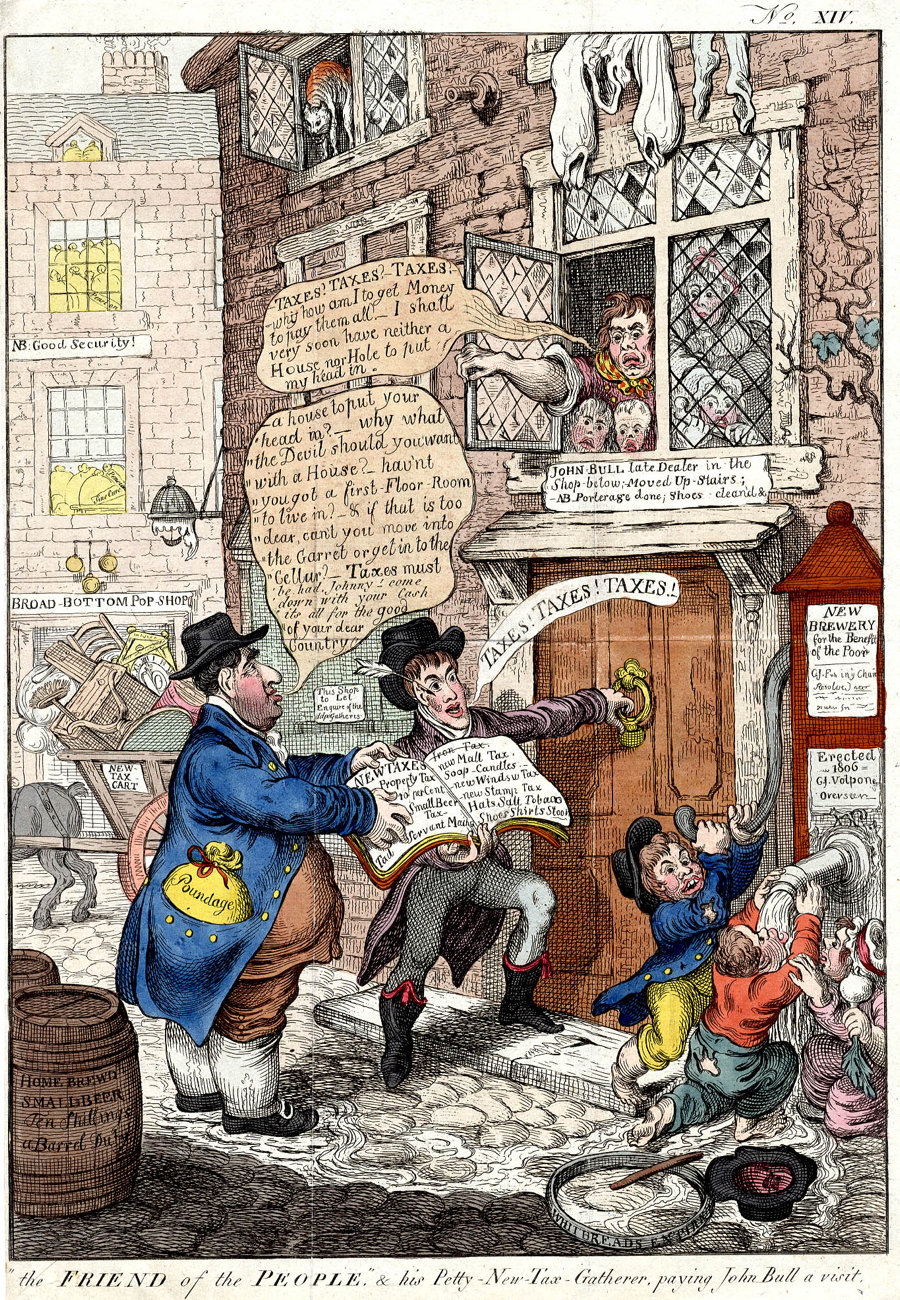 |
"'The FRIEND of the PEOPLE', and his Petty-New-Tax-Gatherer, paying John Bull a visit" (May
28, 1806) |
| Gillray has ironically called the new tax gatherers in this caricature "The Friend of the People" when obviously from the drawing John Bull and his family are in dire financial straits. A thin looking cat stands in an upper window of their house, washing hangs from a window, his wife and family look frightened when the tax gatherers knock on their door demanding payment of the new taxes, one of the children is gnawing on a meatless thigh bone. A withered grape vine grows on the front of the building. The sign above the front door says "John Bull, late Dealer in the Shop below; Moved Up-Stairs; NB. Porterage done; Shoes clean'd &" . John Bull has lost the lease to his shop (a sign outside says "This Shop to Let. Enquire of the Tax-Gatherer") and has had to move upstairs and do much more menial labour to make a living. John Bull says to the tax gatherers "TAXES? TAXES? TAXES? why how am I to get Money to pay them all! I shall very soon have neither a House nor Hole to put my head in." Two sharply dressed tax gathers (one with a quill pen behind his ear in order to write down in his ledger the taxes owed and paid - possibly Lord Henry Petty the Chancellor of the Exchequer) are knocking on the door announcing that they have come to collect the new "TAXES! TAXES! TAXES!" They are holding a book which lists all the new taxes the Bulls must pay: property tax 10%, small beer tax, taxes on servants and maids, iron tax, malt tax, window tax, stamp tax, taxes on hats, salt, tobacco, shoes, shirts, and stools. The portly tax gatherer (possibly Charles James Fox) has a large sack of money in his pocket labelled "poundage" (a percentage of a worker's wages taken by the government) and says to John Bull "a house to put your head in? why what the devil would you want with a House? hav'nt you got a first-Floor Room to live in? & if that is too dear, can't you move into the garret or get in to the Cellar? Taxes must be had. Johnny - come down with your Cash, its all for the good of your dear Country." |
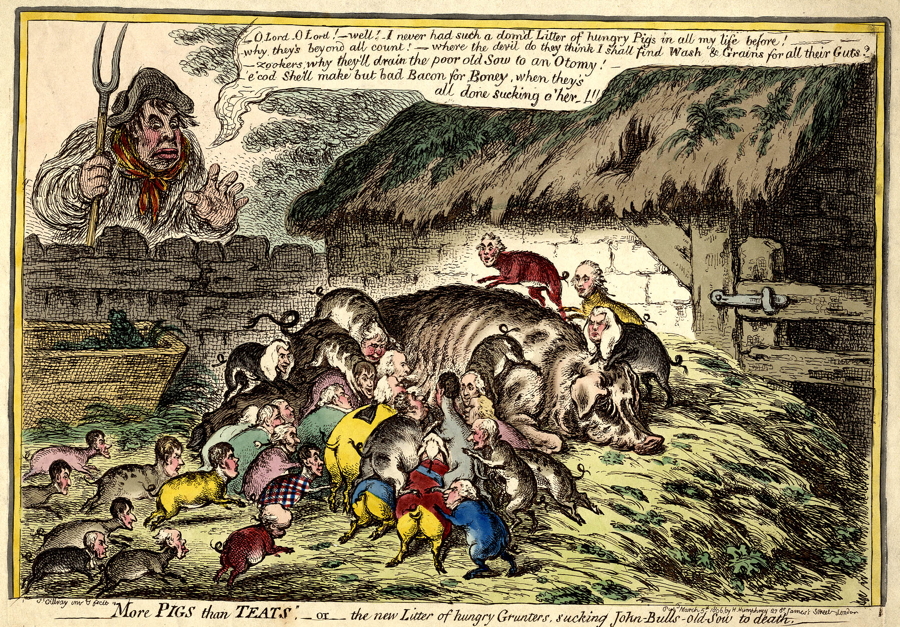 |
"More PIGS than TEATS, or the new Litter of hungry Grunters sucking John Bull's old Sow to death" (March
5, 1806) |
| In this caricature John Bull is shown as a pig farmer who has come to check on his old sow in the pig stye. The sow represents the British economy which was being sucked dry by all the demands being placed upon it by the British government in order to fight the war against Napoleon, especially the new war taxes. Those doing the "sucking" are the vested interests which benefited from the policy of war, such as members of the government, the law, the military, and the aristocracy. John Bull is shocked to see his poor emaciated sow (emaciated and near death, with a very forlorn look on her face) being besieged by "hungry Grunters" wanting to suck at her teats. John Bull says "O Lord. O Lord! I never had such a dam'd Litter of hungry pigs in all my life before! why they's beyond all count! [I count 28 (editor)]. where the devil do they think I shall find Wash & Grains for all their Guts? zookers, why they'll drain the poor old Sow to an Otomy! (?) e'cod She'll make but bad Bacon for Boney [the English nickname for Napoleon Bonaparte], when they's all done sucking o'her!!!" |
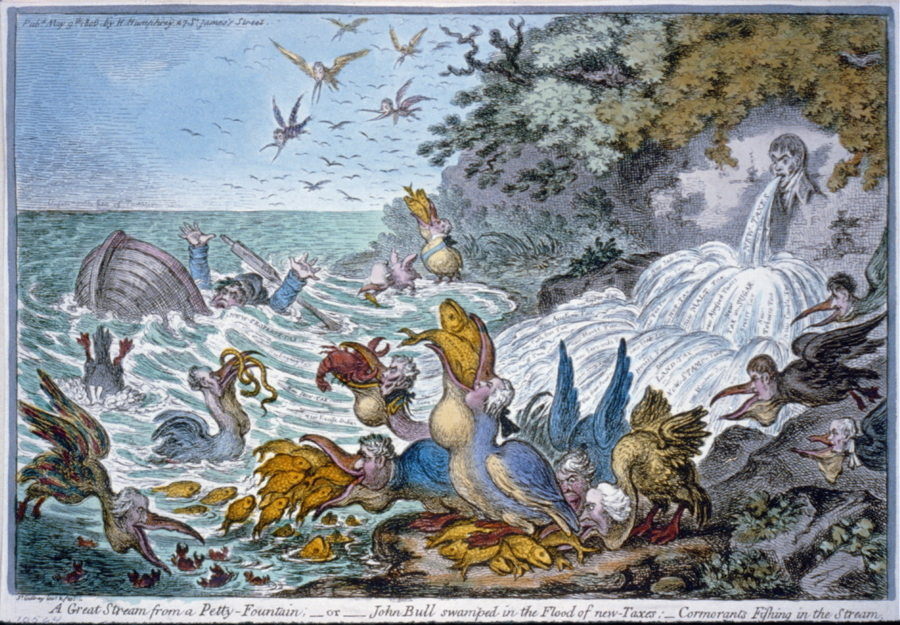 |
James Gillray, "A Great Stream from a Petty-Fountain; or John Bull swamped in the Flood of new-Taxes; Cormorants Fishing the Stream" (1806) |
| In this caricature, on the left we see John Bull (the personification of Britain) in a sinking boat which has been swamped by a mass of new taxes to fund the war against Napoleon. He has lost hold of an oar with the name of "William Pitt" written on it. [William Pitt the Younger was Prime Minister from 1804-1806 as well as Chancellor of the Exchequer (or minister of finance)]. On the right we see a man's head (probably Lord Henry Petty the new Chancellor of the Exchequer) from whose mouth pours a fountain of water labeled "new taxes" which are named in the cascades of the fountain (taxes on salt, tea, hops, malt, sugar, alcohol, candles, horses, servants, soap, houses, land, stamps, windows, property, etc.). In the foreground we see 10 hungry cormorants with human heads devouring the fish, crabs, and eels which thrive in the waters of the tax fountain. In the middle ground there are 2 other human-headed birds; in the distance we can see dozens more hungry cormorants heading towards the tax feast. The heads of the cormorants probably depict prominent politicians and other figures of the day. Wright and Evans observe that the Whig party when it was in opposition had opposed heavey taxation but as soon as they were able to form a government they not only retained all the taxes of the old government but introduced a large number of new ones. The Whig's new budget was brought down by the Chancellor of the Exchequer, Lord Henry Petty, whose face can be seen on the right disgorging a stream of new taxes. The cormorants depict the hungry new Whig politicians who eagerly snap up the tax revenues which flow their way. Their heads are those of Windham, Grey, Lord Derby, Duke of Bedford, Fox, Lord Moira, Lord Grenville, Sherdian, Lord Sidmouth, Tierney, Lord H. Petty, Sir F. Burdett, Horne Tooke. [pp. 261-62, no. 313]. |
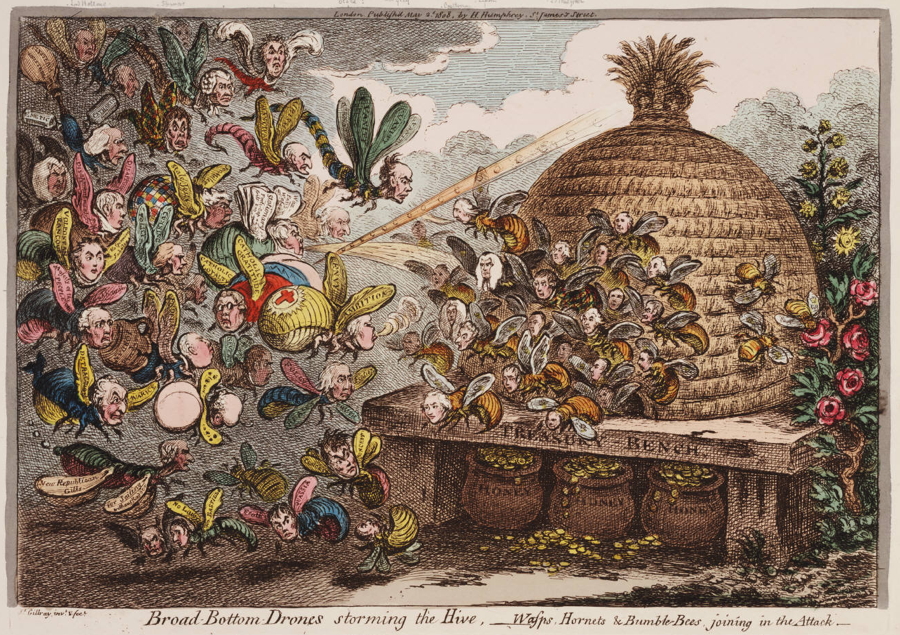 |
"Broad-Bottom Drones storming the Hive, Wasps, Hornets & Bumble Bees joining the Attack" (May
2, 1808) |
| The expression "Broad-Bottom" in the title refers to a coalition of politicians from both parties (Whig and Tory) who essentially agree on pursuing a common policy which in this case was increased taxation to fight the war against Napoleon. Hence, the attack on the Treasury was a bi-partisan movement by all the vested interests and power groups within the establishment to make use of the increased government revuenue made possible by higher and more numerous taxes imposed upon the British people. On the right is a beehive which represents the British treasury. The monarch's crown sits on the top and the hive rests on a wooden table on which is written "Treasury Bench". Beneath this are three pots named "Honey" which are brimming over with coins showing the prosperity and wealth of Britain. To the right of the hive we see three productive honey bees collecting nectar in what looks to be the flowers of a rose bush. In front of the hive are 21 bees who have come forward to protect the hive from marauding wasps, hornets, and bumble bees who have come to steal the hive's honey. These insects perhaps represent all the vested interest groups seeking money and other benefits from the government, or those groups which cost the Treasury money (say for defence). The bees appear to have beaten off one attack - the six insects at the lower left who have turned tail and are retreating. On their wings are written slogans which reveal their affiliation. Most are illegible but one has a pair of wings on which is written "No Laws" and "No Bastille", another has "Incest", suggesting that the British Treasury has been able to defeat the worst of the French Revolution. The face of the bee leading the defense has well defined human features and is probably meant to be Spencer Perceval who was Chancellor of the Exchequer from 1807-1809 and who was able to maintain the war against Napoleon without raising taxes and by cutting costs. |